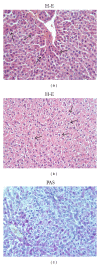Beneficial effects of montelukast against methotrexate-induced liver toxicity: a biochemical and histological study
- PMID: 22566785
- PMCID: PMC3329899
- DOI: 10.1100/2012/987508
Beneficial effects of montelukast against methotrexate-induced liver toxicity: a biochemical and histological study
Abstract
The effects of montelukast against methotrexate-induced liver damage were investigated. 35 Wistar albino female rats were divided into 5 groups as follows: group I: control; group II: montelukast (ML); group III: methotrexate (Mtx); group IV: montelukast treatment after methotrexate application (Mtx + ML); group V: montelukast treatment before methotrexate application (ML + Mtx). At the end of the experiment, the liver tissues of rats were removed. Malondialdehyde (MDA), myeloperoxidase (MPO), and reduced glutathione levels were determined from liver tissues. In addition, the liver tissues were examined histologically. MDA and MPO levels of Mtx group were significantly increased when compared to control group. In Mtx + ML group, these parameters were decreased as compared to Mtx group. Mtx injection exhibited major histological alterations such as eosinophilic staining and swelling of hepatocytes. The glycogen storage in hepatocytes was observed as decreased by periodic acid schiff staining in Mtx group as compared to controls. ML treatment did not completely ameliorate the lesions and milder degenerative alterations as loss of the glycogen content was still present. It was showed that montelukast treatment after methotrexate application could reduce methotrexate-induced experimental liver damage.
Figures



References
-
- Bayram M, Ozogul C, Dursun A, Ercan ZS, Isik I, Dilekoz E. Light and electron microscope examination of the effects of methotrexate on the endosalpinx. European Journal of Obstetrics Gynecology and Reproductive Biology. 2005;120(1):96–103. - PubMed
-
- Widemann BC, Balis FM, Kempf-Bielack B, et al. High-dose methotrexate-induced nephrotoxicity in patients with osteosarcoma: incidence, treatment, and outcome. Cancer. 2004;100(10):2222–2232. - PubMed
-
- Vardi N, Parlakpinar H, Cetin A, Erdogan A, Ozturk IC. Protective effect of β-carotene on methotrexate-induced oxidative liver damage. Toxicologic Pathology. 2010;38(4):592–597. - PubMed
-
- Vardi N, Parlakpinar H, Ozturk F, et al. Potent protective effect of apricot and β-carotene on methotrexate-induced intestinal oxidative damage in rats. Food and Chemical Toxicology. 2008;46(9):3015–3022. - PubMed
-
- West SG. Methotrexate hepatoxicity. Rheumatic Disease Clinics of North America. 1997;23:883–915. - PubMed
MeSH terms
Substances
LinkOut - more resources
Full Text Sources
Medical
Research Materials
Miscellaneous

